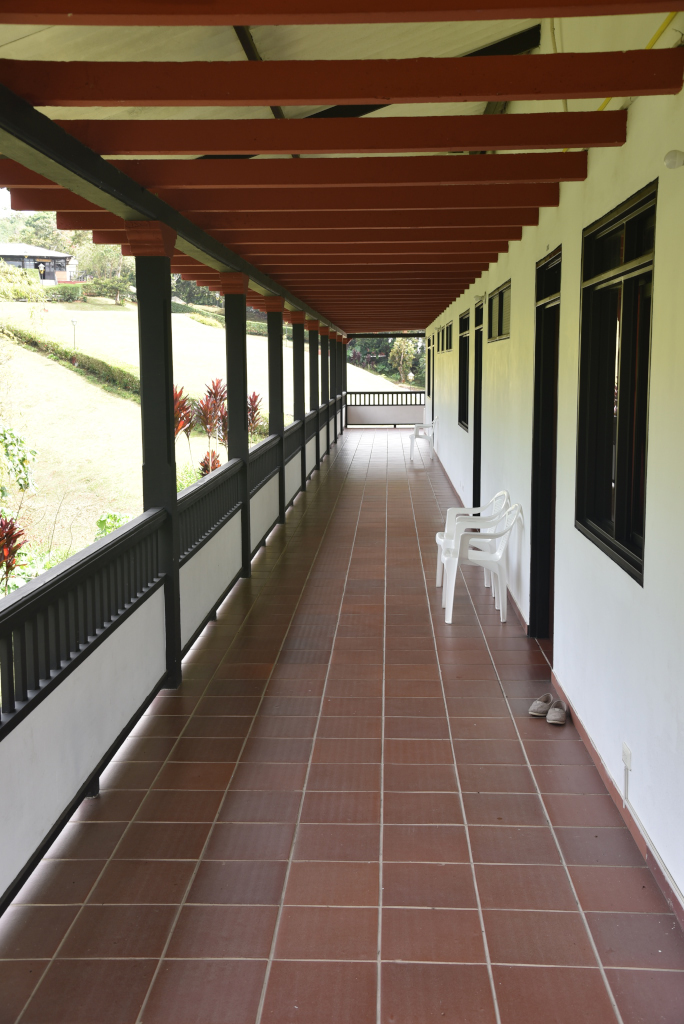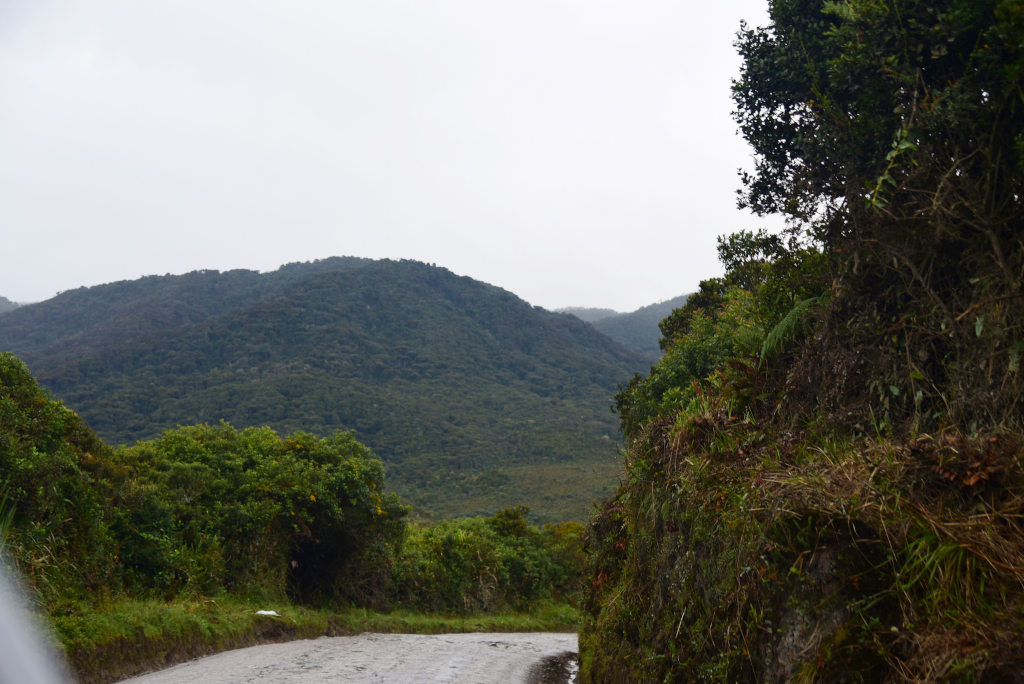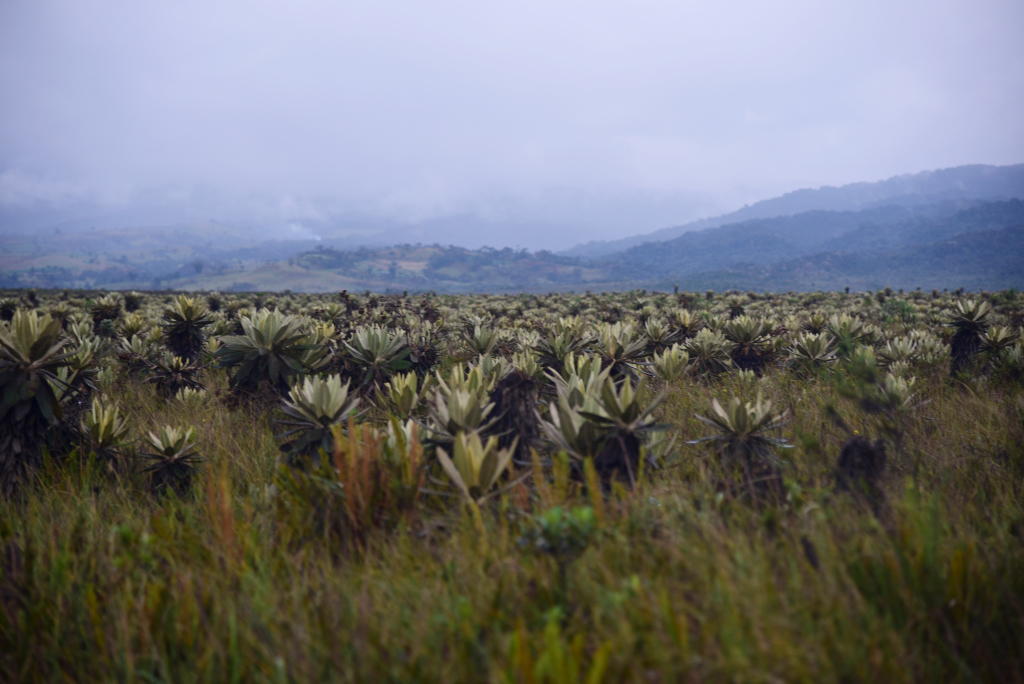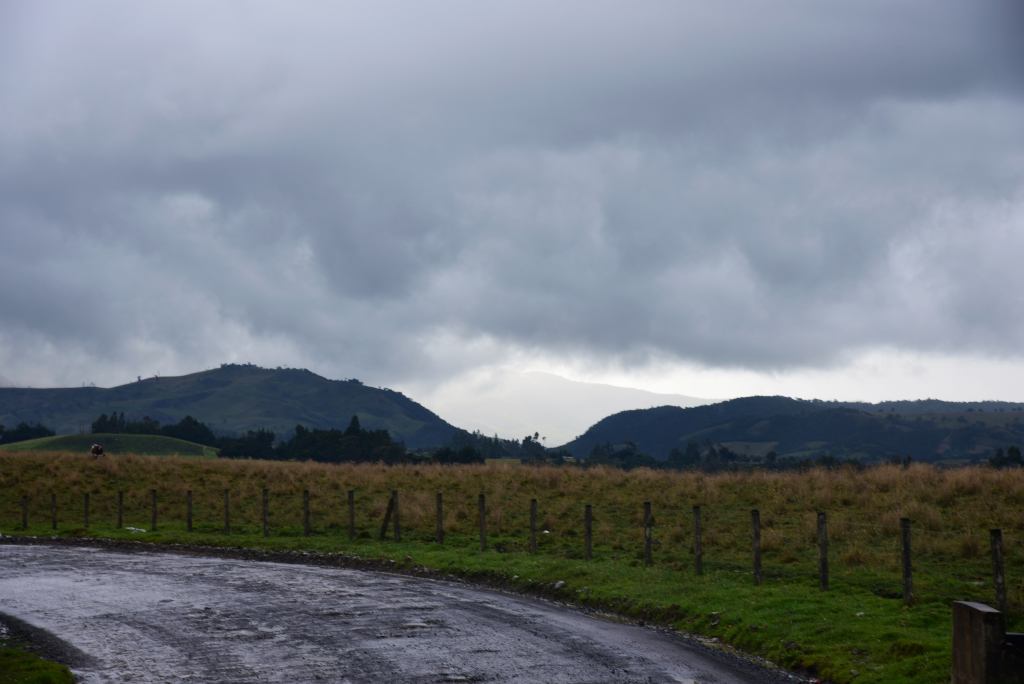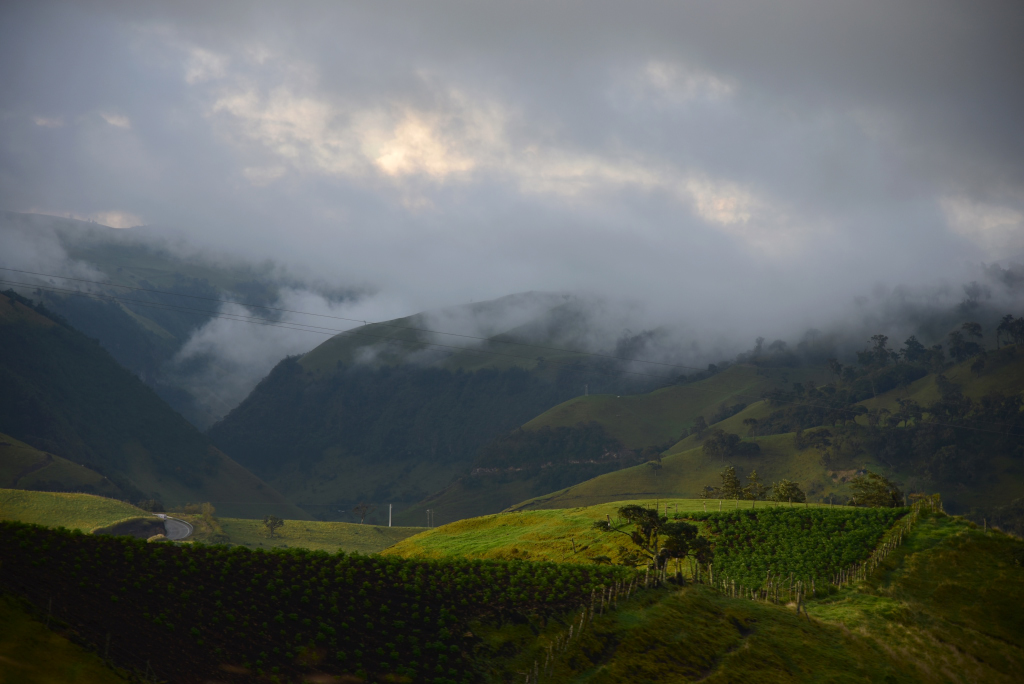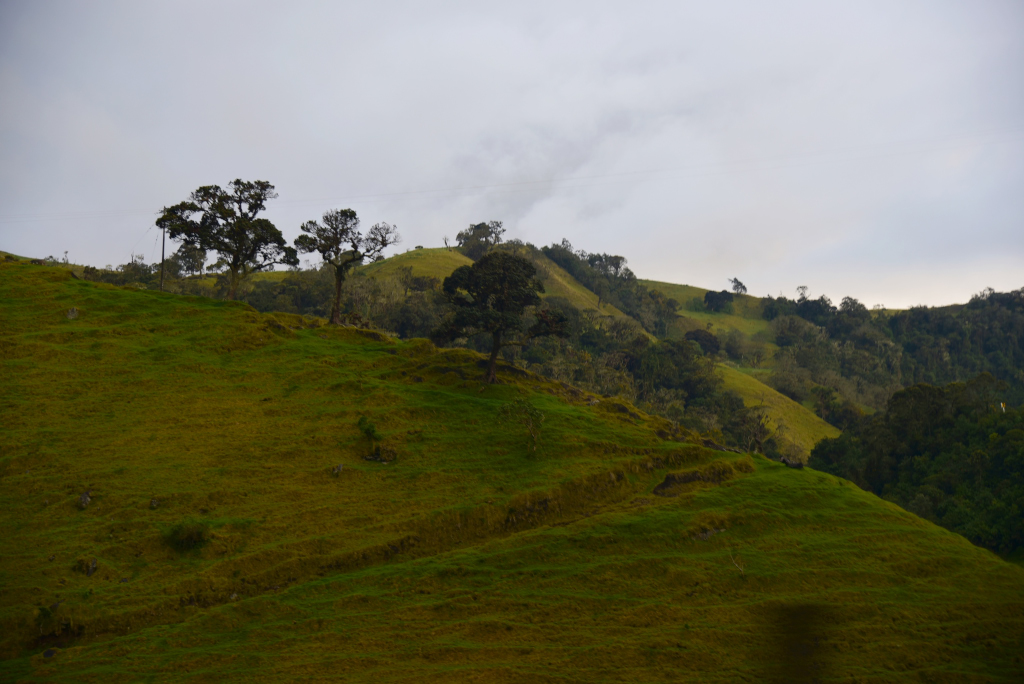March 24, 2018
Today I travel to Popayán, located on the western side of the Cordillera Central. I start the day off with one last relaxed breakfast at my posh hotel in the forest. I imagine I will have to cut short the usual drawn-out writing exercise, given that I am not sure of how far Popayán is from here, and for that matter, how heavily booked bus passages are. It occurs to me that I may have to wait an inordinately long time to get on any bus heading to the town that warrants the most attention in the country during the Semana Santa (which is about to begin).
I am assured by Eduardo, ever patient with my random and digressive requests, that there is direct service at various points during the day to Popayán. He calls the agency in question and books me the last seat on the buseta, leaving me to enjoy my last few hours organizing my affairs peacefully in the hotel room, rather than charging off to San Agustín on a potential wild goose chase.
I am the first passenger the minivan picks up, which also means that I enjoy the choice of seats, in particular, picking the one in the cab with high head room. The remaining vehicles fills up in town with visitors, mostly European, including a young woman from Amiens, France, who is studying in Bogotá, and wants to look for work as a nanny in Canada or Switzerland this coming summer, and behind us, two elderly women from Finistere, Brittany, who during the trip manage to chat up a storm with the younger Colombian man sitting next to them, who invites the two to his village in the Nariño. I would love to go myself, but alas, given travel times and the amount of time left, I will be heading north prior to returning to the capital city.
As we rise into the mountains, the landscape becomes increasingly dramatic, the hills covered in thick forest, ridges with cascading waterfalls emerging from chasms revealed to us as we round serpentine curves, climbing further into the ominous sky, although the skies restrain themselves, no more than a drizzle emitting as we climb further and further. It becomes apparent that the landscape we are traversing is completely untouched, coated with virgin rain forest that is stunningly beautiful, part of the country’s relentless assault on the senses.
The wild space around becomes more dramatic yet, more lush, more gorgeous, bereft of any sort of settlement, people, stores, anything: pure unadulterated wilderness. And for good reason, as much of the area between San Agustín and Popayán lies in the Parque Nacional Natural Puracé. We traverse segments of road that are actually newly paved, but by far the majority of the road is very rough and potholed, and must absolutely destroy vehicles that pass through here on a regular basis. I simply don’t understand the economics of providing regular public transport service on a road that is this terrible!
Parque Nacional Natural Puracé is the source of the major rivers in Colombia, including the Magdalena, Cauca, Patía and Caquetá. The park features some 30 lagoons and 11 volcanoes, including Pan de Azúcar (5,000 ms), Puracé (4,780 ms), and Coconuco (4,600 ms), the only active one. Some hundred years ago, the sierra was covered in snow, now no snow whatsoever is found in the mountains. The driver tells me that there really is nowhere to stay in the park, which seems somewhat strange, given its size. As much an area of its size would be dedicated to conservation, it also makes sense to allocate some marginal area to recreational purposes for people to enjoy, if anything to get buy in from the public to garner support for the space. The driver points to a small muddy inset at the side of the road that we pass by at one point – that’s it, that’s where you can park. Then not far away is a 30 minute trail that leads to a lagoon, but that’s about it.
I would love to get some photos of this park, but due a stroke of bad luck, all the stunning vistas are visible from the other side of the vehicle, and we are so cramped as it is, the poor woman next to me has to suffer every time I haul out my camera and try to take some photos from my side. What’s more, we are proceeding at such a speed and the sky is cloudy enough that the photos shot by my camera are simply too blurred and dark to be of any value. ¡Que lastima!
I am absolutely starving. We have been hurtling along this rough, potholed road for quite some time now, and the breakfast I ate this morning has long since been digested and the caloric value used up. I am starting to look and feel anorexic. And yet, seemingly in the middle of nowhere, the driver stops at a small shack surrounded by the páramo as far as the eye can see. An elderly native couple patiently serves us simply deep-fried pastries akin to bannock, as well as empanadas stuffed with some sort of potato puree that are simply amazing. I can’t stop raving about how good the food is, and as amusing at the other backpackers find me, I am probably a bit too far outside the realm of experience for the owners of the tienda to comprehend.
The store marks the end of the national park, and soon after we enter a small settlement that never seems to end, scattered houses lining the road as we weave downhill towards our inevitable destination, lying on the other side of one of the country’s major cordilleras. The sun is emerging from the heavy cloud cover, bathing parts of the sculpted green mountainsides in golden light, while leaving others in darkness. The landscape again become dramatic, but in an entirely different manner than when were climbing into the mountains from San Agustín.
The bus station seems to be somewhat of a modern affair, or rather, with a plethora of fast food stands that typically don’t make an appearance at Colombian bus stations. Nearby is a huge shopping mall with Exito as anchor tenant. My taxi pulls out of the bus station and advances through the streets of Popayán. Popayán doesn’t make much of an impression, but then notably, not much of a bad impression – until we reach the city centre, from one city block to the next the town’ face converting to a city of whitewashed adobe palaces hearkening centuries back in time. Seen from the core area, the city is an absolute jewel, the narrow alleys looking out over this fantastical world bustling with life.
But it seems I will not be staying in the city centre, given that the car slowly continues through the heavy traffic on the narrow streets leading out of town. I scrutinize the streets, looking at the buildings becoming more dilapidated, but we don’t go far, weaving around some newer residential buildings with modest gated fronts, built on diagonal blocks.
The driver stops in front of one building, telling me we have arrived. We have arrived where? The number on the house doesn’t correspond to the number I provided, and where is the Santa Inés church? A problem I find consistently with local taxi drivers is that they are not particularly motivated and often don’t know the urban landscape well enough to know where they are going. I reprimand the driver, but think of travelers who often don’t speak much Spanish, and the added issue of safety challenges, particularly in deserted areas in the evening, which this area qualifies as. The driver continues, finding what looks to be the house in question – but the gate is closed and locked, there is no buzzer, or for that matter, no sign of life.
Sigh … AirBnB is another big problem in Colombia. The people just don’t understand what should be on the table as far as hosting is concerned. The lack of professionalism becomes really annoying. And of course, where every living creature in the country has a cell phone, this driver claims he doesn’t. Or more likely, he does, but doesn’t want me to consume his precious minutes, and hence is lying about it. So we find a pay phone, the driver arranging with the woman to open the door. We return, and there she is, having opened a total of three doors with four keys, which almost require a manual to proceed through. She tells me we should have honked: I look at her somewhat dumbfoundedly – so we should just create a racket because you couldn’t bother opening the door?
The house in question is spacious, with a number of bedrooms circling a set of common rooms, including a study, a living room, dining room, a salon, and a kitchen, all of which will apparently be at my disposal when the owner leaves to visit her daughter for a month in Medellin. I will of course not be here that long, but it could be a bit of a lonely experience! Hopefully the celebrations in the town will be exciting enough to keep me busy … not that I don’t have oodles of work to do in the time I am here, beginning with figuring out how to open and close the doors.
We chat, discussing the house and any requirements she may have for me (very few), and then I want to leave for the town to at least eat before everything closes. She insists that there are fantastic restaurants here, but that remains to be seen. The walk into town isn’t particularly long, although even with the short distance, the instructions I was given seem to be a bit off. But no matter – I am heading to the Parque Caldas, which is somewhat at the centre of the grid-patterned Spanish colonial town.
Walking through the town illuminated with the glow of the gas lamp-style illumination, the whitewashed colonial facades are evocative of a different era, much more grandiose than what I saw in Villa de Leyva, although this is obviously also more of a real city, not just a place that exists for touristic purposes. And yet the old town is cordoned off with the tape used to demarcate crime scenes, with police omnipresent. Businesses seem to be largely closed, and only closer to the square do I see throngs of people gathered, and runners in numbered sports uniforms – in fact, a lot of people running.
A loud, militaristic chanting erupts from a group of young men running in synchronized fashion, physically in far better shape than any of their cohorts on the street. Indeed, they are soldiers, their chiseled physiques intended to impress, but around them are throngs of other runners, possibly physically less impressive, but running a marathon in some fashion. And there are a lot of runners, more and more coming at me, to the point that it is obvious that this is a national race, having attracted people from all over the country.
I am amazed, since most of the runners are in reasonably good shape, no one looks like they are about to collapse, a real tribute to the athleticism apparent and celebrated in this country. But I am on a different mission, and that is to find the Italian restaurant the AirBnB owner told me about. Most businesses are closed, and even though they may be much posher in appearance, the usual suspects remain open, bakeries and also cafes. There are a few restaurants, but basic local-style places that would be the last choice.
On the main place, a stage and bleachers have been erected, large crowds gathered to participate in some concluding celebration which I want no part in – I just want to get to the restaurant. But where is it? It was supposed to be some two blocks beyond the main square, but I have now walked all around the inner town, and have seen nothing but a lot of runners, lots of police, beyond the inner blocks the human presence virtually evaporating (hence a potential security concern) – but no Italian restaurant.
And there it is – although it doesn’t help that the sign for the restaurant is high above the entrance, which I would never have seen from the street without craning my neck. And as luck has it, I manage to get the last table in the place with cavernous ceilings, in a corner on the upstairs balcony. As much as the waiter rushes to meet clients’ demands, wait times are inevitably long, given how many mouths need to be fed here. But the pizza I order turns out to be excellent, almost surprisingly so, although perhaps less so, considering that the charming and welcoming owner happens to be French Swiss …



